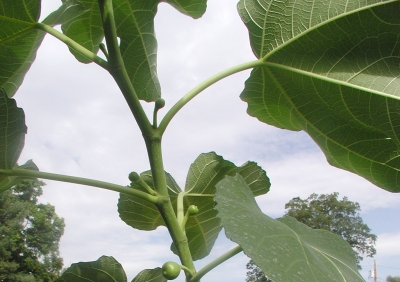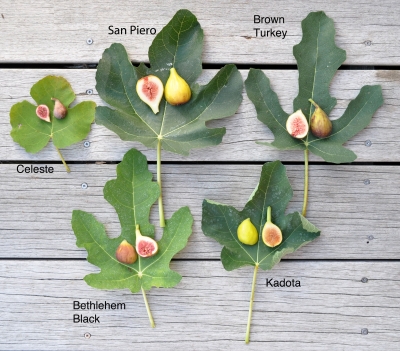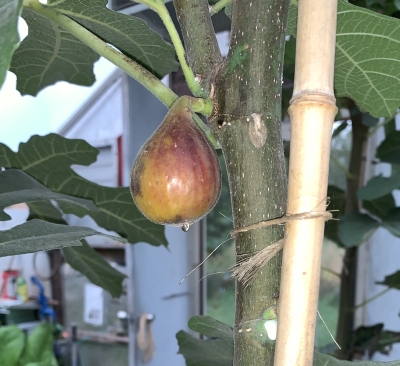WAITING FOR FIGS
(Much of the below information is gleaned from my book Growing Figs in Cold Climates and a video I presented, now available online.)
Affliction
If you’re not growing figs because you think your cold winter climate is wrong for them, you’re wrong and you’re missing out on an exotic treat. Figs can be grown just about everywhere. If you are growing figs and you’re in a cold winter climate, the fruits should be nearly or already ripening.
Impatience is the affliction of the cold climate fig grower. I’m feeling it right now, as I write. That impatience comes from watching little figlets forming and expanding early in the season and then just sitting on the branches, doing nothing, seemingly forever. Knowing something of how fig fruits develop and grow, and ways that ripening can be hastened along helps soothe my affliction.
of how fig fruits develop and grow, and ways that ripening can be hastened along helps soothe my affliction.
Let Me Know Thy Ways (of Fruiting)
Most varieties of figs bear fruit on new, growing shoots. This bearing habit is very different from that of most common fruits, such as apples, peaches, and blueberries, which bear fruit on stems that are one-year-old or older. (Some fig varieties do bear on one-year-old stems, and some bear on both one-year-old and new, growing shoots.) Figs’ bearing habit is a boon to cold climate fig growers because that means that a fig tree can still bear fruit even if its stems freeze back or are pruned back rather severely.

Figs forming on new shoot
But it takes time for fruits on young fig stems to develop and ripen, which they do sequentially from the bottom (the oldest) part of the growing stem to the top. The closer a stem originates to the roots, the longer it takes for fruit on that stem to develop and ripen. That time could be too long, depending on how severely the plant was pruned or froze back and the length of the growing season. I like to develop and leave one or more permanent trunks at least two feet long, letting sprouts grow from or at their tops.
Some so-called “hardy” figs sprout new shoots from ground level after dying back from winter cold. Actually, since ground temperatures in winter are milder than air temperatures, many figs will do this. Problem is that figs will form on those sprouts from ground level but may not have time to ripen.
Quicken the Pace
Assuming a portion of trunk or trunks have survived winter, perhaps because the plant was potted and moved to shelter, the trunk was insulated, or the trunk was buried, etc., impatience still lurks. (I detail a number of ways to get figs through winter in my book Growing Figs in Cold Climates.) The problem — for us, not the figs — is that fruit growth follows a sigmoidal (S-shaped) curve over time. That is, the fruits swell up rapidly early in the season, then just sit for a long time.
But hang tight. If all else is in order, fruit growth leaves the flat part of the curve, and figs start to rapidly swell, at the same time softening and developing a rich, sweet flavor. How long before ripening begins depends on the where the fruiting shoot originated, the variety, and the growing season.
Fortunately, you can hasten along ripening to some degree. The first way is earlier in the season, when a shoot has just a few leaves, say about five. If you pinch out the growing tip, that could stimulate figs down along the stem to start developing sooner than if the stem was left alone. However, doing so also might reduce total yield because shoot growth is at least temporarily stalled.
As fruits near ripening, they can be hurried along by “oiling.” Do this by putting a drop of olive oil in the eye of a fruit; I just dip a chopstick in the oil and then let the oil drip off onto the eye.  Very important: Don’t try this on a fruit very far from ripening, which is, of course, hard to tell until the fruit starts ripening. But if you really love your fig tree, you’ve been staring at it a lot. As you do so you’ll begin to notice subtle changes. I’ve typically used this method towards the end of the growing season when fig ripening slows with waning sunlight and cooling temperatures.
Very important: Don’t try this on a fruit very far from ripening, which is, of course, hard to tell until the fruit starts ripening. But if you really love your fig tree, you’ve been staring at it a lot. As you do so you’ll begin to notice subtle changes. I’ve typically used this method towards the end of the growing season when fig ripening slows with waning sunlight and cooling temperatures.
Wait!
Whatever you do, don’t harvest any figs before they are fully ripe. Figs, like many other fruits do not ripen at all once they have been harvested. Incipient rot might make harvested, underripe fruits a bit sweeter, but that’s different from ripe. Commercial figs are harvested just short of full ripeness because then they can be shipped without damage.

When your fig is fully ripe, the fruit is soft and perhaps has a “tear” in its eye. The flavor will be sweet and rich.


Diane again in Goshen, NY. I have a fig tree, this is my third year, and it is covered with figs! I have been a little worriesd because nothing seems to be happening, thanks for this post. Mine is a brown turkey, a shoot from one of my sister’s trees in Virginia. July 27th she ate her first ripe one, on the 30th she picked 6 pounds. I bring it into my garage in winter, it’s a brown turkey.
Be patient. Those harvest dates at your sister’s seem early, even in Virginia. (I’ve grown figs in southern Delaware and in Maryland.
Swarthmore , PA.
Most beautiful and abundant brebe crop
All being eaten by grackles.
Tried toy snakes , shiny streamers
All quiet now. Rest of figs too small.
A net?
We found an article in the Oct. 2021 NY Times about growing figs in cold weather climates. Looked you up and found your blog. Our daughter and her family live in Gardiner and wondered if we could see your plants when we’re visiting.
We have a second home in Point Pleasant Beach that gets more sun than our north Jersey property. We took a cutting from a neighbor and have been trying to get ripe figs for about 10 years. The plant grows large each summer (currently about 10 feet) with many figs, but most never seem to get a long enough season to ripen.
As far as visiting, call me when you’re in the area and I may have some time. As far as figs at the beach, the problem is that your plant’s stems are dying too far back to the ground. Select one or just a few of the oldest stems to protect from winter cold, and cut back every else. Shorten the stems that you save back to no shorter than 2-3 feet. Of course, all this is more thoroughly covered in my book GROWINNG FIGS IN COLD CLIMATES.
Thanks for these comments. So I have 2 (I believe Brown Turkey) that are about ten years old, multiple trunked and 5-6 ft tall. They didn’t bear much this year.
Would it be best to select 2-3 major trunks and cut the others down to pot level, and let new growth in Spring grow, or tip back slightly as you suggest?
They are quite root bound and I was going to repot them with fresh soil this Fall and back into the same pots. They are about 20 gallon clay pots.
Is there a fertilizer you recommend
I would suggest repotting the plant, selecting 2-3 trunks and removing all others, and then, when growth begins, to remove any new growth originating below about 2 feet above soil. To could cut back the 2-3 trunks you save if they are getting too tall, but don’t shorten them below a couple of feet or so above the soil line.
This year most of my figs ripened. However, the green figs did not. I have read that by cutting off half the figs it will help the remaining figs ripen. Is there any truth to this?
Could be. But if by “green figs” you mean unripe ones (vs a variety with green fruit), they probably will not ripen. Main crop figs ripen sequentially at the end of summer, the oldest ones first. The youngest ones, though starting to form, may not have enough time, depending on the variety and the length of you growing season. I suggest taking a look at my book GROWING FIGS IN COLD CLIIMATES.
Hello! I just finished reading your article about the anticipation of figs, and I have to say, your writing has a wonderfully captivating way of drawing readers into your experiences. As I read through your words, I could almost feel the excitement and patience that comes with waiting for those delicious figs to ripen.
Your connection with nature and the changing seasons really shines through in your writing. It’s heartwarming to read about your journey of nurturing the fig trees and the sense of reward that comes with it. The details you provided about the fig’s growth stages and the anticipation of that perfect moment for picking them were truly intriguing.
Thank you so much for those compliments. I put a lot of effort into these posts and comments like yours are one thing that keep me writing.
I live in zone 7b and my figs are behaving strangely this year. They put on fruit at the end of July, but it never ripened even though we got our first freeze at the end of November. So I picked off all the shriveled, frost bitten fruits, the leaves all fell off like normal. I looked at them this morning (December 16), and they were putting on fruit again! Should I pick them off or will tiny fruits overwinter some they don’t have a lot of water in them? We had a bad drought all of October, had a lot of rain in November, but not enough to officially get us out of drought conditions. We’ve had pretty mild weather with just a few nights that have briefly dipped into the upper 20’s, but daytime temps are between 40-60. Varieties are Chicago, brown turkey and black mission. Is this normal with crazy weather? The trees are all between 4-7 years old, planted near walls with either south or western face.
“Put on fruit” means, I assume, when first fruitlets form. It can take a long time before those fruitlets become ripe fruits. Main crop fruits that get a late start often don’t ripen, depending on the length of the growing season.
Is far as the fruitlets not forming, I not sure what to suggest. You could leave them, hoping they would ripen a brea crop. Except that Brown Turkey and Chicago generally don’t form breba crops. Black Mission does, or is supposed to. Mine never did. And its main crop ripens very late for me.